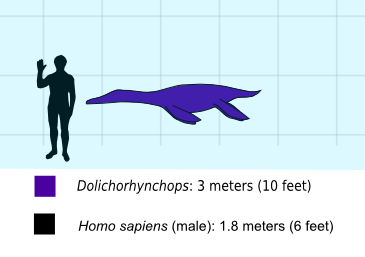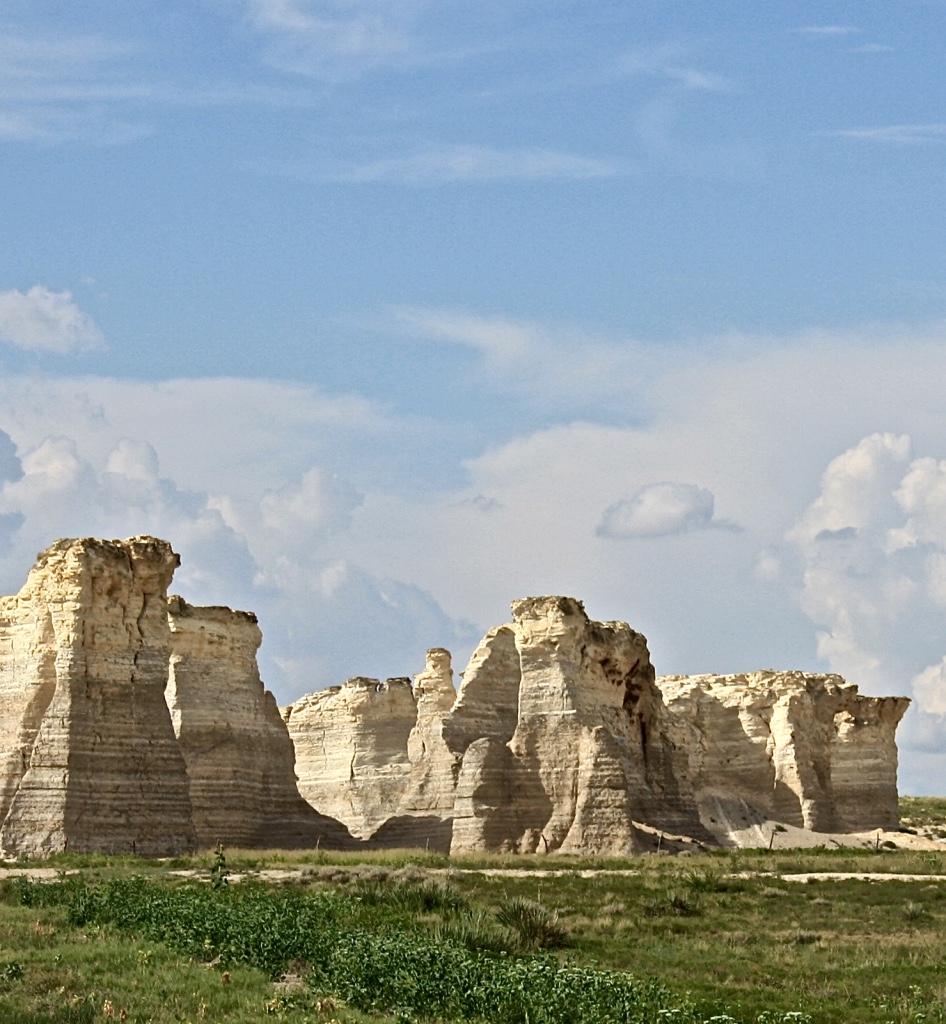|
Dolichorhynchops Osborni
''Dolichorhynchops'' is an extinct genus of polycotylid plesiosaur from the Late Cretaceous (early Turonian to late Campanian stage) of North America, containing three species, ''D. osborni'', ''D. bonneri'' and ''D. tropicensis'', as well as a questionably referred fourth species, ''D. herschelensis''. ''Dolichorhynchops'' was an oceangoing prehistoric reptile. Its Greek generic name means "long-nosed face". Discovery and species ''D. osborni'' The holotype specimen of ''Dolichorhynchops osborni'' was discovered in the upper Smoky Hill Chalk Logan County, Kansas, by George F. Sternberg, as a teenager, in around 1900. The remains were collected by him and his father, Charles H. Sternberg, and then sold to the University of Kansas (Lawrence, Kansas). KUVP 1300 was prepared and mounted by H.T. Martin under the supervision of Dr. Samuel Wendell Williston, who described and named it in 1902. A more detailed description and photographs were provided by ). The specimen has been on ... [...More Info...] [...Related Items...] OR: [Wikipedia] [Google] [Baidu] |
Late Cretaceous
The Late Cretaceous (100.5–66 Ma) is the younger of two epochs into which the Cretaceous Period is divided in the geologic time scale. Rock strata from this epoch form the Upper Cretaceous Series. The Cretaceous is named after ''creta'', the Latin word for the white limestone known as chalk. The chalk of northern France and the white cliffs of south-eastern England date from the Cretaceous Period. Climate During the Late Cretaceous, the climate was warmer than present, although throughout the period a cooling trend is evident. The tropics became restricted to equatorial regions and northern latitudes experienced markedly more seasonal climatic conditions. Geography Due to plate tectonics, the Americas were gradually moving westward, causing the Atlantic Ocean to expand. The Western Interior Seaway divided North America into eastern and western halves; Appalachia and Laramidia. India maintained a northward course towards Asia. In the Southern Hemisphere, Australia a ... [...More Info...] [...Related Items...] OR: [Wikipedia] [Google] [Baidu] |
Dolichorhynchops Osborni
''Dolichorhynchops'' is an extinct genus of polycotylid plesiosaur from the Late Cretaceous (early Turonian to late Campanian stage) of North America, containing three species, ''D. osborni'', ''D. bonneri'' and ''D. tropicensis'', as well as a questionably referred fourth species, ''D. herschelensis''. ''Dolichorhynchops'' was an oceangoing prehistoric reptile. Its Greek generic name means "long-nosed face". Discovery and species ''D. osborni'' The holotype specimen of ''Dolichorhynchops osborni'' was discovered in the upper Smoky Hill Chalk Logan County, Kansas, by George F. Sternberg, as a teenager, in around 1900. The remains were collected by him and his father, Charles H. Sternberg, and then sold to the University of Kansas (Lawrence, Kansas). KUVP 1300 was prepared and mounted by H.T. Martin under the supervision of Dr. Samuel Wendell Williston, who described and named it in 1902. A more detailed description and photographs were provided by ). The specimen has been on ... [...More Info...] [...Related Items...] OR: [Wikipedia] [Google] [Baidu] |
Maastrichtian
The Maastrichtian () is, in the ICS geologic timescale, the latest age (uppermost stage) of the Late Cretaceous Epoch or Upper Cretaceous Series, the Cretaceous Period or System, and of the Mesozoic Era or Erathem. It spanned the interval from . The Maastrichtian was preceded by the Campanian and succeeded by the Danian (part of the Paleogene and Paleocene). The Cretaceous–Paleogene extinction event (formerly known as the Cretaceous–Tertiary extinction event) occurred at the end of this age. In this mass extinction, many commonly recognized groups such as non-avian dinosaurs, plesiosaurs and mosasaurs, as well as many other lesser-known groups, died out. The cause of the extinction is most commonly linked to an asteroid about wide colliding with Earth, ending the Cretaceous. Stratigraphic definitions Definition The Maastrichtian was introduced into scientific literature by Belgian geologist André Hubert Dumont in 1849, after studying rock strata of the ... [...More Info...] [...Related Items...] OR: [Wikipedia] [Google] [Baidu] |
Canada
Canada is a country in North America. Its ten provinces and three territories extend from the Atlantic Ocean to the Pacific Ocean and northward into the Arctic Ocean, covering over , making it the world's second-largest country by total area. Its southern and western border with the United States, stretching , is the world's longest binational land border. Canada's capital is Ottawa, and its three largest metropolitan areas are Toronto, Montreal, and Vancouver. Indigenous peoples have continuously inhabited what is now Canada for thousands of years. Beginning in the 16th century, British and French expeditions explored and later settled along the Atlantic coast. As a consequence of various armed conflicts, France ceded nearly all of its colonies in North America in 1763. In 1867, with the union of three British North American colonies through Confederation, Canada was formed as a federal dominion of four provinces. This began an accretion of provinces and ... [...More Info...] [...Related Items...] OR: [Wikipedia] [Google] [Baidu] |
Saskatchewan
Saskatchewan ( ; ) is a province in western Canada, bordered on the west by Alberta, on the north by the Northwest Territories, on the east by Manitoba, to the northeast by Nunavut, and on the south by the U.S. states of Montana and North Dakota. Saskatchewan and Alberta are the only landlocked provinces of Canada. In 2022, Saskatchewan's population was estimated at 1,205,119. Nearly 10% of Saskatchewan’s total area of is fresh water, mostly rivers, reservoirs and lakes. Residents primarily live in the southern prairie half of the province, while the northern half is mostly forested and sparsely populated. Roughly half live in the province's largest city Saskatoon or the provincial capital Regina. Other notable cities include Prince Albert, Moose Jaw, Yorkton, Swift Current, North Battleford, Melfort, and the border city Lloydminster. English is the primary language of the province, with 82.4% of Saskatchewanians speaking English as their first language. Saska ... [...More Info...] [...Related Items...] OR: [Wikipedia] [Google] [Baidu] |
Bearpaw Formation
The Bearpaw Formation, also called the Bearpaw Shale, is a geologic formation of Late Cretaceous (Campanian) age. It outcrops in the U.S. state of Montana, as well as the Canadian provinces of Alberta and Saskatchewan, and was named for the Bear Paw Mountains in Montana. It includes a wide range of marine fossils, as well as the remains of a few dinosaurs. It is known for its fossil ammonites, some of which are mined in Alberta to produce the organic gemstone ammolite. Lithology and depositional environment The formation was deposited in the Bearpaw Sea, which was part of the Western Interior Seaway that advanced and then retreated across the region during Campanian time. It is composed primarily of dark grey shales, claystones, silty claystones and siltstones, with subordinate silty sandstones. It also includes bedded and nodular concretions (both calcareous and ironstone concretions) and thin beds of bentonite. As the seaway retreated toward the southwest, the marine sedime ... [...More Info...] [...Related Items...] OR: [Wikipedia] [Google] [Baidu] |
Niobrara Formation
The Niobrara Formation , also called the Niobrara Chalk, is a geologic formation in North America that was deposited between 87 and 82 million years ago during the Coniacian, Santonian, and Campanian stages of the Late Cretaceous. It is composed of two structural units, the Smoky Hill Chalk Member overlying the Fort Hays Limestone Member. The chalk formed from the accumulation of coccoliths from microorganisms living in what was once the Western Interior Seaway, an inland sea that divided the continent of North America during much of the Cretaceous. It underlies much of the Great Plains of the US and Canada. Evidence of vertebrate life is common throughout the formation and includes specimens of plesiosaurs, mosasaurs, and pterosaurs as well as several primitive aquatic birds. The type locality for the Niobrara Chalk is the Niobrara River in Knox County in northeastern Nebraska. The formation gives its name to the Niobrara cycle of the Western Interior Seaway. History of ... [...More Info...] [...Related Items...] OR: [Wikipedia] [Google] [Baidu] |
Dolichorhynchops Scale
''Dolichorhynchops'' is an extinct genus of polycotylid plesiosaur from the Late Cretaceous (early Turonian to late Campanian stage) of North America, containing three species, ''D. osborni'', ''D. bonneri'' and ''D. tropicensis'', as well as a questionably referred fourth species, ''D. herschelensis''. ''Dolichorhynchops'' was an oceangoing prehistoric reptile. Its Greek generic name means "long-nosed face". Discovery and species ''D. osborni'' The holotype specimen of ''Dolichorhynchops osborni'' was discovered in the upper Smoky Hill Chalk Logan County, Kansas, by George F. Sternberg, as a teenager, in around 1900. The remains were collected by him and his father, Charles H. Sternberg, and then sold to the University of Kansas (Lawrence, Kansas). KUVP 1300 was prepared and mounted by H.T. Martin under the supervision of Dr. Samuel Wendell Williston, who described and named it in 1902. A more detailed description and photographs were provided by ). The specimen has been on ... [...More Info...] [...Related Items...] OR: [Wikipedia] [Google] [Baidu] |
A Prehistoric Adventure
A, or a, is the first letter and the first vowel of the Latin alphabet, used in the modern English alphabet, the alphabets of other western European languages and others worldwide. Its name in English is ''a'' (pronounced ), plural ''aes''. It is similar in shape to the Ancient Greek letter alpha, from which it derives. The uppercase version consists of the two slanting sides of a triangle, crossed in the middle by a horizontal bar. The lowercase version can be written in two forms: the double-storey a and single-storey ɑ. The latter is commonly used in handwriting and fonts based on it, especially fonts intended to be read by children, and is also found in italic type. In English grammar, " a", and its variant " an", are indefinite articles. History The earliest certain ancestor of "A" is aleph (also written 'aleph), the first letter of the Phoenician alphabet, which consisted entirely of consonants (for that reason, it is also called an abjad to distinguish it fro ... [...More Info...] [...Related Items...] OR: [Wikipedia] [Google] [Baidu] |
Documentary Film
A documentary film or documentary is a non-fictional motion-picture intended to "document reality, primarily for the purposes of instruction, education or maintaining a historical record". Bill Nichols has characterized the documentary in terms of "a filmmaking practice, a cinematic tradition, and mode of audience reception hat remainsa practice without clear boundaries". Early documentary films, originally called " actuality films", lasted one minute or less. Over time, documentaries have evolved to become longer in length, and to include more categories. Some examples are educational, observational and docufiction. Documentaries are very informative, and are often used within schools as a resource to teach various principles. Documentary filmmakers have a responsibility to be truthful to their vision of the world without intentionally misrepresenting a topic. Social-media platforms (such as YouTube) have provided an avenue for the growth of the documentary- film genre ... [...More Info...] [...Related Items...] OR: [Wikipedia] [Google] [Baidu] |
IMAX
IMAX is a proprietary system of high-resolution cameras, film formats, film projectors, and theaters known for having very large screens with a tall aspect ratio (approximately either 1.43:1 or 1.90:1) and steep stadium seating. Graeme Ferguson, Roman Kroitor, Robert Kerr, and William C. Shaw were the co-founders of what would be named the IMAX Corporation (founded in September 1967 as Multiscreen Corporation, Limited), and they developed the first IMAX cinema projection standards in the late 1960s and early 1970s in Canada. IMAX GT is the large format as originally conceived. It uses very large screens of and, unlike most conventional film projectors, the film runs horizontally so that the image width can be greater than the width of the film stock. It is called a 70/15 format. It is used exclusively in purpose-built theaters and dome theaters, and many installations limit themselves to a projection of high quality, short documentaries. The high costs involved ... [...More Info...] [...Related Items...] OR: [Wikipedia] [Google] [Baidu] |








